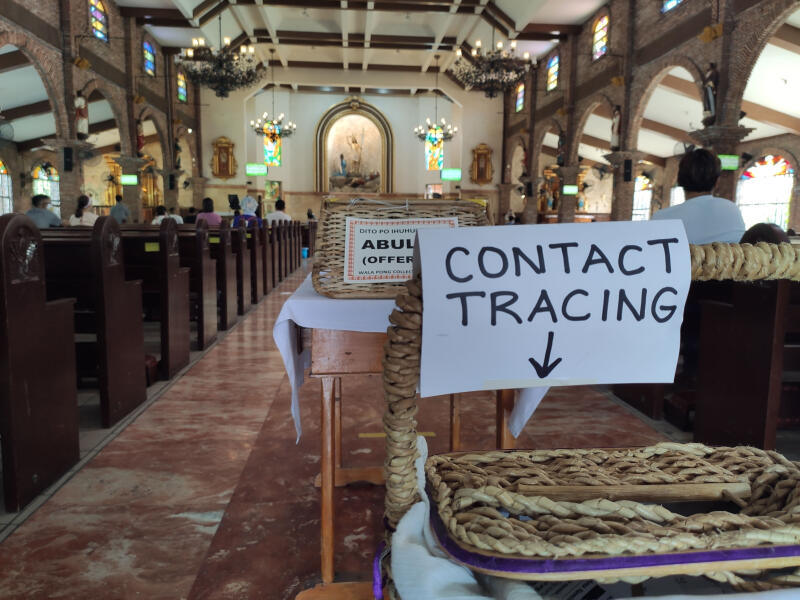MANILA - After being shut for more than three months, the doors of a Catholic church in Molino town, south of the capital Manila, finally reopened on Saturday (July 11) morning.
But fewer than a dozen people walked through those doors.
"They're still cautious," said Reverend Ned Nazareno, 38.
By Sunday, attendance improved. There were around 60 who came to hear Father Nazareno say mass.
The church could actually seat 10 times as many. But with a coronavirus outbreak still raging, many are opting to celebrate their faith the way they have since the Philippines went on lockdown more than three months ago: online, and on TV and radio.
Church officials have rolled out a slew of precautions since the government allowed churches, mosques, synagogues and temples to reopen this month.
All places of worship were closed when President Rodrigo Duterte put most of the Philippines on lockdown in March to slow the spread of the coronavirus.
For now, churches can admit only up to 10 per cent of their usual capacity.
At Father Nazareno's church, only one parishioner sits on an entire pew that has enough space for 10.

A nearby cathedral in Imus city, meanwhile, closes its massive, wooden doors when there are already 120 people inside, although it lets those who come in late to hear mass at the parking lot, with marshals making sure they are spaced metres apart.
Everyone has to wear masks. Churchgoers are screened before they are led in. Their body temperatures are taken, and they have to fill out forms indicating their addresses and phone numbers for contact tracing.
Some parts of the mass have also been tweaked.
There are no longer ushers who go from pew to pew collecting money during mass. Instead, churchgoers drop their contributions into a wicker basket just outside the door.
Greetings of "peace be with you", previously done with a handshake, an embrace or a kiss, are now executed with just a nod.
Choirs can still sing church hymns. But where there used to be 10 singers standing shoulder to shoulder, only two, spaced far apart, are now allowed.
At Father Nazareno's church, only the pianist, two singers and the person in charge of the projector sit at the choir's corner.
"We do away with the harmonies. We just sing louder," said Ms Chesty Bonita, 37.
She said choir members are supposed to wear masks all the time while in church. But that is not possible when they have to sing.
"I can't sing through my mask and be understood, let alone be heard," she said.
She said it is difficult and sometimes it does not make sense to go on.
"But I'm just glad I can go back to church and sing again. I just miss singing," she said.
That is the sentiment common among those who are again making their way to their churches to celebrate mass there instead of inside their living rooms.
"I feel closer to God this way," said churchgoer Dionisio Alpombre, 80.
Asked if he was afraid of getting the virus, especially as he is in the most vulnerable group, given his age, he replied: "I am. But when it's your time to go, it's your time to go."
For the Catholic Church, the reopening comes with a bit of financial relief.
Nearly 80 per cent of the 100 million people in the Philippines are Catholic.
Most of the Church's parishes and dioceses rely on the little sums these 80 million Catholics give when they attend mass.
When the country was placed on lockdown, the church migrated online and priests were live-streaming masses.
While that allowed the church to stay connected to its flock, the money dried up.
Many churches have had to dip into their bank savings, or seek emergency funding from their dioceses.
Reverend Reymar Arca, 39, from the Imus cathedral,said he knew of a few churches who may soon go bankrupt.
They may have to let go of their administrative staff, rely on volunteers for their upkeep, and reach out to their most devoted parishioners to raise funds to keep the electricity and water running.
Father Nazareno said his church managed to survive three months of lockdown only with the charity of its flock.
"Whenever we'd almost run out of supplies, people would come in with food, water, some money," he said.
He is hoping the government will further relax its rules for church.
He also wants to see at least half the church filled with people and more masses being celebrated on Sundays.
But all that will depend on how well the church can keep the virus out.
"They'll shut us down again if even just one churchgoer tests positive," said Father Nazareno.













